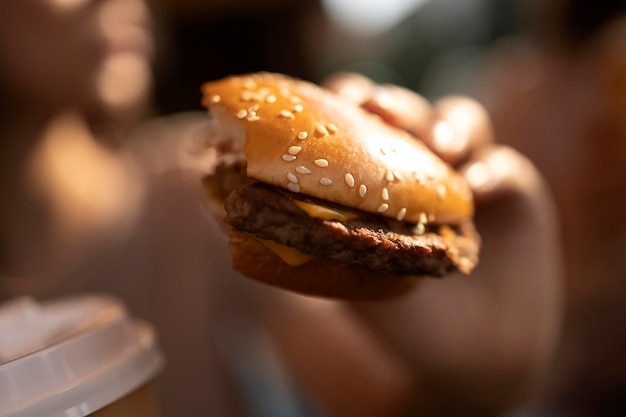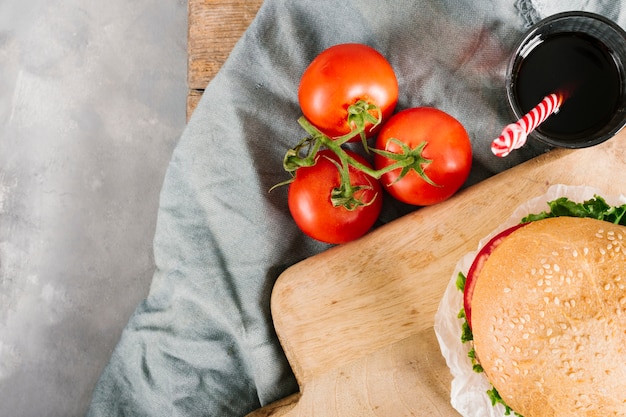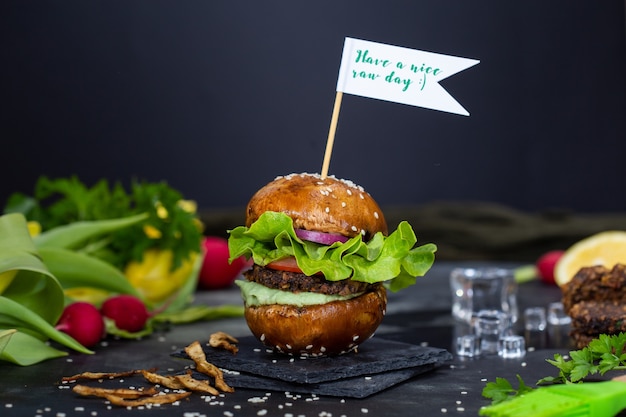Let's face it, there's nothing quite like sinking your teeth into a perfectly cooked burger. A juicy patty, melting cheese, crisp veggies, and a tangy sauce - it's pure culinary heaven. But achieving that perfect burger can feel like a gamble. One minute it's perfectly pink and juicy, the next it's dry and disappointing.
I've been on a lifelong quest for the perfect burger, experimenting with different techniques and grilling more than my fair share of patties. So, I figured it was time to share my hard-earned knowledge with you and help you achieve burger perfection every single time.
This guide will dive deep into the world of burger cook times, exploring the factors that influence the cooking process and arming you with the tools to create juicy, flavorful burgers that will have everyone begging for seconds.
Ready to embark on this culinary adventure? Let's get started!
(Part 1) Understanding the Fundamentals

Before we delve into specific cook times, it's essential to grasp the basic principles that govern the art of burger cooking.
The Science Behind burger cook times
Burger cooking, at its core, is about achieving the ideal internal temperature. We want a temperature that eliminates any potentially harmful bacteria while still leaving the meat juicy and succulent.
Key Factors Influencing Cook Time
Several factors come into play when deciding how long to cook your burger. Let's break them down:
- Patty Thickness: A thicker patty, naturally, takes longer to cook through. A thin patty cooks faster, while a thick one requires more time to reach the desired temperature.
- Type of Meat: Different cuts of meat have varying fat content, which directly impacts the cooking time. Leaner meat tends to cook faster, while fattier meat takes longer due to its higher moisture content.
- Grill or Pan Heat: A hotter grill or pan will cook your burger more quickly. A scorching hot surface can lead to burning, while a gentler heat allows for a more even cook.
The Importance of safe internal temperature
The USDA recommends cooking burgers to an internal temperature of 160°F (71°C) to ensure they're safe to eat. However, this is just a guideline. Personal preference plays a significant role. Some people adore their burgers cooked to a slightly lower temperature, preferring a more "pink" center.
(Part 2) The Ultimate Burger Cook Time Chart

Now, let's get down to the nitty-gritty. This handy chart serves as your guide to various burger cook times, based on patty thickness and desired level of doneness:
| Patty Thickness (inches) | Rare (130-135°F) | Medium-Rare (135-140°F) | Medium (140-150°F) | Medium-Well (150-160°F) | Well-Done (160°F ) |
|---|---|---|---|---|---|
| 1/2 inch | 2-3 minutes per side | 3-4 minutes per side | 4-5 minutes per side | 5-6 minutes per side | 6-7 minutes per side |
| 3/4 inch | 3-4 minutes per side | 4-5 minutes per side | 5-6 minutes per side | 6-7 minutes per side | 7-8 minutes per side |
| 1 inch | 4-5 minutes per side | 5-6 minutes per side | 6-7 minutes per side | 7-8 minutes per side | 8-9 minutes per side |
Remember, these are just guidelines. Factors like the heat of your grill or pan can influence the cook time, so it's always a good idea to use a meat thermometer for accuracy.
(Part 3) Exploring Different Cooking Methods

Now that we've laid the groundwork, let's explore the various methods you can use to cook your perfect burger:
1. The Classic: Grilling
Grilling is the go-to method for burger enthusiasts, imparting that irresistible smoky flavor.
- Preheat Your Grill: Preheat your grill to medium-high heat. This ensures a nice sear on the outside while cooking the patty evenly.
- Oil the Grates: Brush your grill grates with a little oil to prevent sticking. This will make flipping your burger a breeze.
- Cook Time: Place your burgers on the preheated grill and cook for 2-3 minutes per side for a thinner patty or 4-5 minutes for a thicker one.
- Flip Once: Resist the urge to flip your burgers multiple times. One flip is all it takes to achieve a beautiful sear and prevent squishing the patty.
- Temperature Check: Use a meat thermometer to check the internal temperature. This ensures your burger is cooked to your desired level of doneness.
2. A Versatile Option: Pan-Frying
If you lack a grill, pan-frying is a fantastic alternative.
- Heat Your Pan: Heat a cast iron pan or a heavy-bottomed skillet over medium-high heat. Cast iron is ideal for even heat distribution, but any sturdy pan will do.
- Add Oil: Add a small amount of oil to the pan. This prevents sticking and helps to create a lovely crust.
- Cook Time: Place the burgers in the hot pan and cook for 2-3 minutes per side for a thinner patty or 4-5 minutes for a thicker one.
- Flip Once: Just like grilling, one flip is all you need.
- Temperature Check: Use a meat thermometer to ensure your burger is cooked to your liking.
3. The Hands-Off Approach: Oven Baking
Oven baking is a great option if you prefer a less hands-on approach.
- Preheat Your Oven: Preheat your oven to 400°F (204°C). This ensures that the patty cooks through evenly.
- Prepare the Baking Sheet: Place your burgers on a baking sheet lined with parchment paper. This prevents sticking and makes for easy cleanup.
- Cook Time: Bake for 15-20 minutes for a thinner patty or 20-25 minutes for a thicker one.
- Flip Halfway Through: Flip the burgers halfway through cooking to ensure they cook evenly on both sides.
- Temperature Check: Use a meat thermometer to ensure the burger has reached the desired internal temperature.
(Part 4) Tips to Unleash Burger Perfection
Now, let's delve into some insider tips to elevate your burger game and ensure juicy, flavorful results every time:
1. Handle the Meat with Care
When forming your patties, avoid overworking the meat. This can lead to a tough burger. Gently shape the patty into your desired form, avoiding excessive pressing or squeezing.
2. Invest in a Meat Thermometer
A meat thermometer is a burger chef's best friend. It removes the guesswork, ensuring your burgers are cooked to your preferred level of doneness.
3. Allow the Burgers to Rest
After cooking your burgers, let them rest for a few minutes before assembling your sandwiches. This allows the juices to redistribute throughout the patty, resulting in a more succulent bite.
4. Resist the Urge to Press
During cooking, avoid pressing down on the burger. This will only squeeze out the precious juices, leaving you with a dry and disappointing burger.
5. Get Creative with Toppings
The sky's the limit when it comes to burger toppings. Experiment with different cheeses, sauces, veggies, and toppings to create your own unique and delicious combinations.
(Part 5) Troubleshooting Common Burger Problems
Even the most experienced burger connoisseurs encounter a few bumps in the road. Here are some common burger problems and how to avoid them:
1. The Burger Sticks to the Grill
If your burger sticks to the grill, it's likely because the grill isn't hot enough or the grates weren't properly oiled. Ensure your grill is preheated to medium-high heat and oil the grates thoroughly before placing the patties on the grill.
2. Burning on the Outside, Raw in the Middle
A burger that burns on the outside but remains raw in the middle is a sign of too much heat or a patty that's too thick. Reduce the grill heat or opt for thinner patties to ensure even cooking.
3. The Burger is Too Dry
A dry burger is usually the result of overcooking or pressing down on the patty during cooking. Use a meat thermometer to monitor the internal temperature, and avoid pressing the patty as it cooks.
(Part 6) Exploring delicious burger Variations
Now, let's spice things up with some tantalizing burger variations:
1. The Classic Cheeseburger
This is the iconic burger, a simple yet satisfying masterpiece.
- A juicy beef patty.
- Melted cheddar cheese.
- Lettuce, tomato, and onion.
- A dollop of mayonnaise.
2. The Bacon Cheeseburger
For those seeking a bit of extra indulgence, this burger is a must-try.
- A juicy beef patty.
- Melted cheddar cheese.
- Crisp bacon.
- Lettuce, tomato, and onion.
- A dollop of mayonnaise.
3. The Mushroom Swiss Burger
A vegetarian delight, this burger is packed with flavor.
- A juicy portobello mushroom cap.
- Melted Swiss cheese.
- caramelized onions.
- Aioli.
4. The Spicy Black Bean Burger
Another veggie-friendly option, this burger delivers a fiery kick.
- A juicy black bean patty.
- Guacamole.
- Pico de Gallo.
- Sriracha mayo.
(Part 7) The Importance of the Perfect Bun
The bun is often overlooked but plays a crucial role in the overall burger experience.
1. Choosing the Right Bun
Opt for a soft and fluffy bun that can hold up to the juicy patty and toppings without falling apart. Brioche, potato, or sesame seed buns are excellent choices.
2. The Art of Toasting
Toasting the bun adds a delightful crunch and prevents it from becoming soggy. You can toast it in a pan, oven, or under the broiler.
3. Avoiding Overstuffing
Don't overdo it with the toppings. Too many toppings can make the bun difficult to handle and eat.
4. Experimenting with Styles
Get creative with different bun styles. Try brioche, pretzel rolls, or even focaccia for a unique twist.
(Part 8) Creating Your Own Burger Patties
homemade burger patties are undeniably superior to store-bought options. They give you complete control over the ingredients and flavor profile.
1. Selecting the Perfect Meat
For the ultimate burger, choose a blend of lean and fatty meat. A mix of 80% lean and 20% fat provides a juicy and flavorful burger.
2. Simple Seasoning
Salt and pepper are all you need to season your burger patties. Avoid overusing spices, which can overpower the natural flavor of the meat.
3. Gentle Mixing
Overmixing the meat will lead to a tough burger. Gently mix the ingredients until just combined.
4. Forming the Patties
Shape the patties into a uniform size and thickness. This ensures even cooking.
5. Chilling Before Cooking
Chill the patties in the refrigerator for at least 30 minutes before cooking. This helps them hold their shape and cook more evenly.
(Part 9) FAQs
Here are some frequently asked questions about burger cook times:
1. How Do I Know if My Burger is Cooked to the Right Temperature?
The most reliable method is to use a meat thermometer inserted into the thickest part of the patty.
2. What If I Don’t Have a Meat Thermometer?
If you're without a meat thermometer, check the burger by pressing on it. A well-done burger will feel firm, while a medium-rare burger will be soft and slightly squishy.
3. What are the Signs of a Properly Cooked Burger?
A properly cooked burger should have a nice brown crust on the outside. When you cut into it, the juices should run clear, not pink.
4. Can I Cook Burgers in the Microwave?
While you can cook burgers in the microwave, it's not recommended. microwave cooking doesn't yield the same flavor and texture as grilling, pan-frying, or baking.
5. How Do I Store Leftover Burgers?
If you have leftover burgers, store them in an airtight container in the refrigerator for up to 3 days. You can reheat them in the microwave or oven, or even grill them again for a crispy exterior.
(Part 10) The Final Word
There you have it, a comprehensive guide to achieving burger perfection. Remember, the key is to cook your burger to your preferred level of doneness and enjoy the process. Don't be afraid to experiment with different toppings, methods, and variations.
Now, go forth and create burger masterpieces that will leave everyone speechless!
Everyone is watching

Prime Rib Roast Cooking Time Chart: Per Pound Guide
Cooking TipsPrime rib roast. Just the name conjures images of lavish dinners, crackling fires, and hearty laughter. It’s ...

How Long to Bake Potatoes in the Oven (Perfect Every Time)
Cooking TipsBaked potatoes are a staple in my kitchen. They're incredibly versatile, delicious, and surprisingly easy to m...

Perfect Rice Every Time: The Ultimate Guide to Cooking Rice
Cooking TipsAs a self-proclaimed foodie, I've always been a bit obsessed with rice. It's the foundation of countless cuisi...

The Ultimate Guide to Cooking Asparagus: Tips, Techniques, and Recipes
Cooking TipsAsparagus. The mere mention of this spring delicacy conjures up images of vibrant green spears, crisp and burs...

Ultimate Guide to Cooking the Perfect Thanksgiving Turkey
Cooking TipsThanksgiving. Just the word conjures up images of overflowing tables laden with delicious food, the scent of r...
